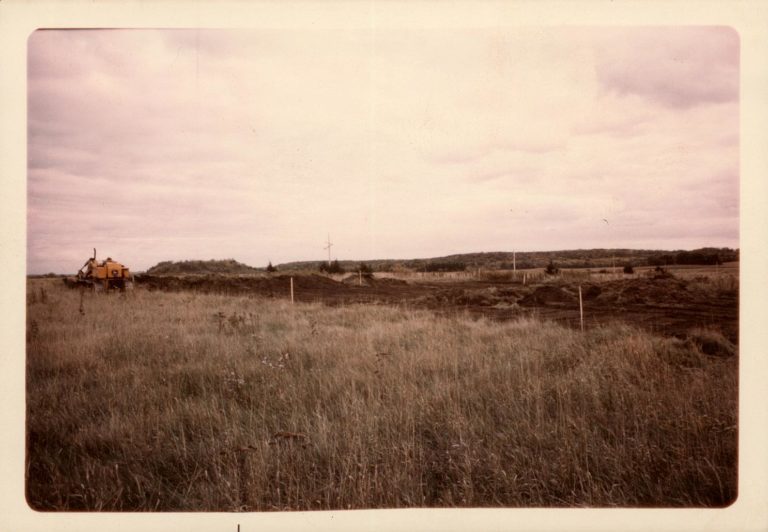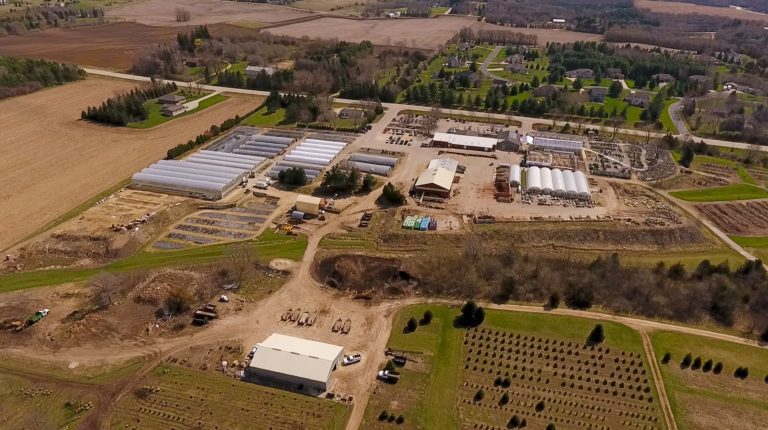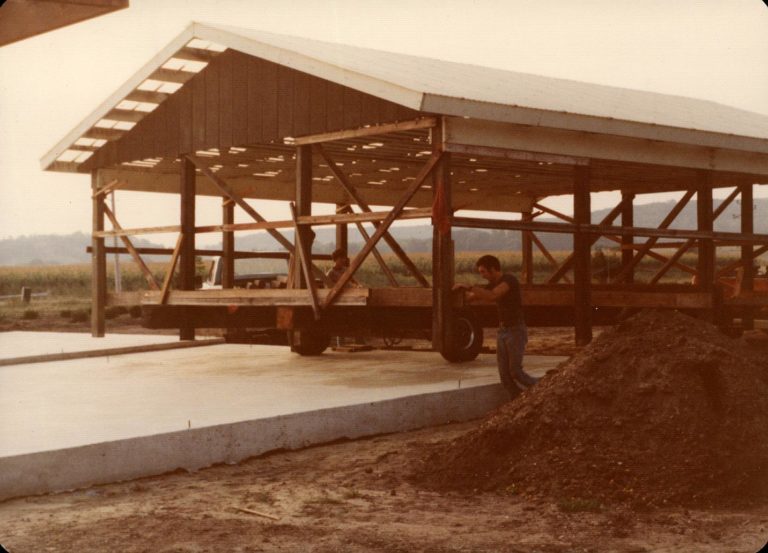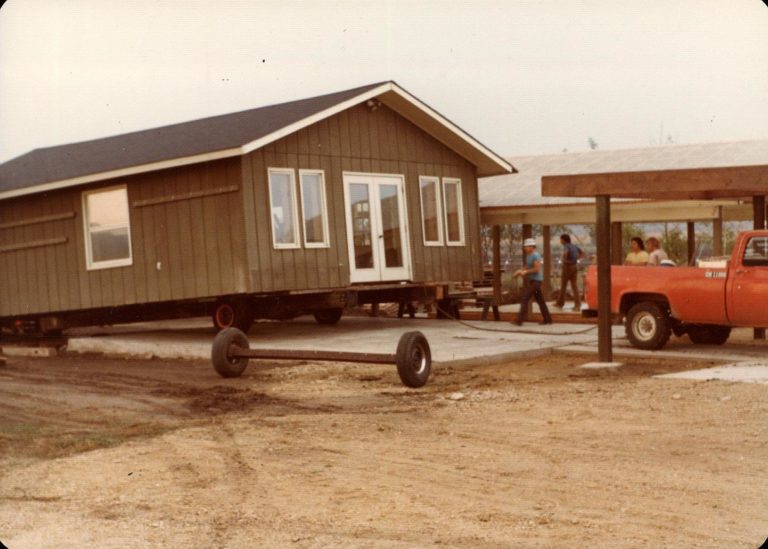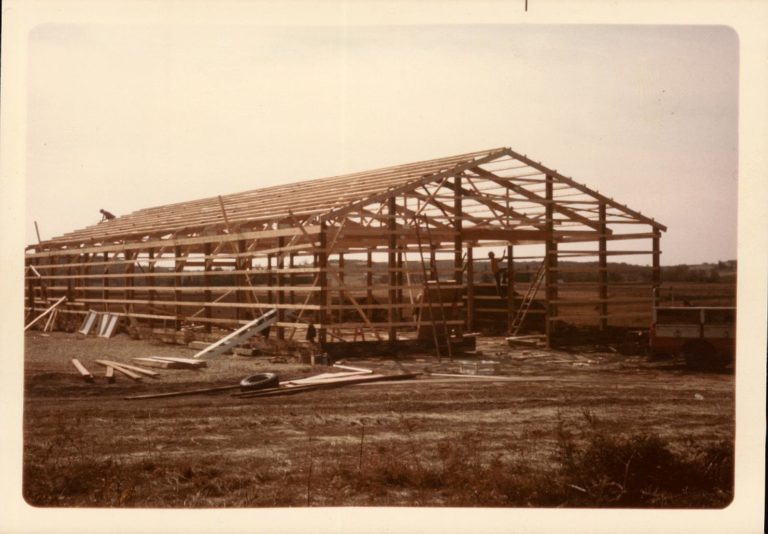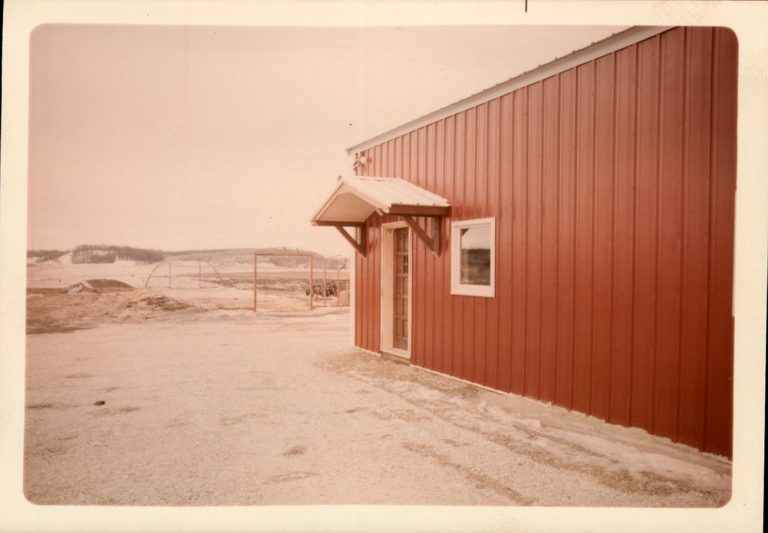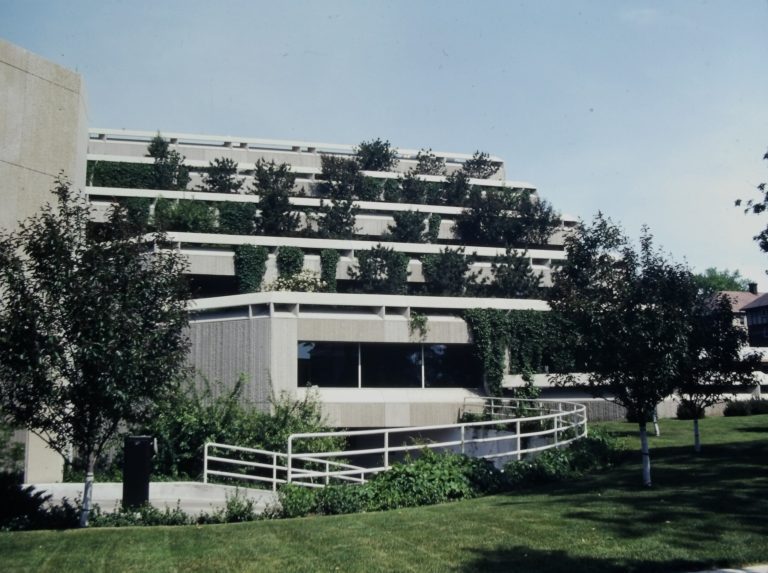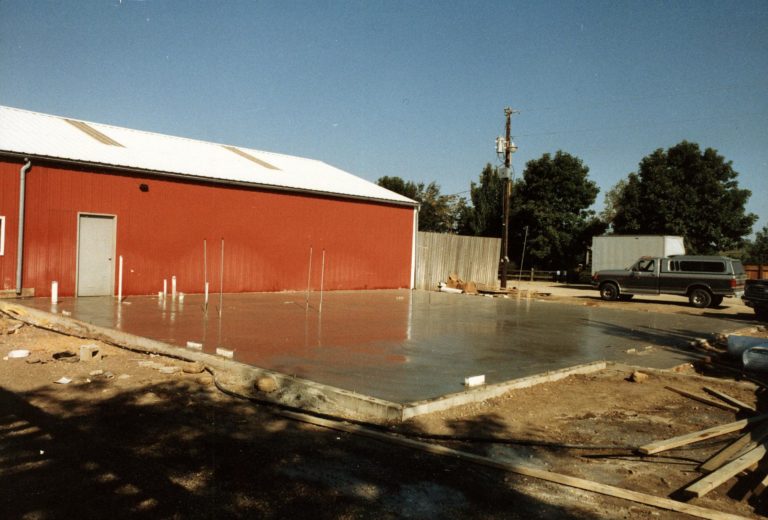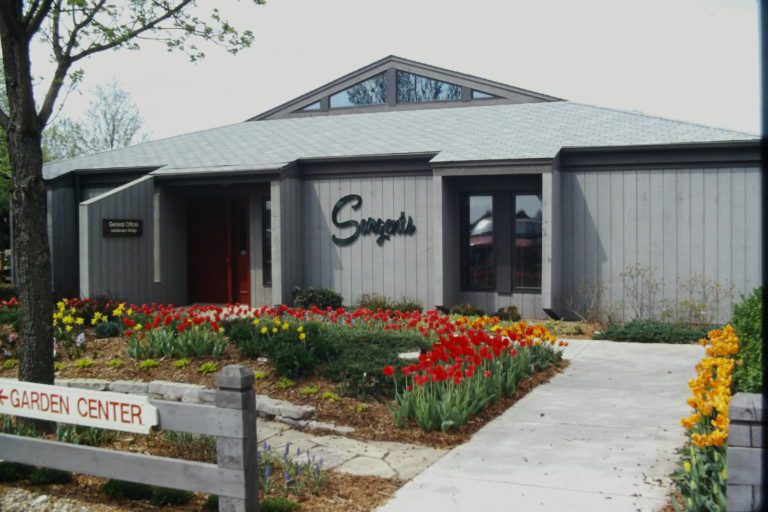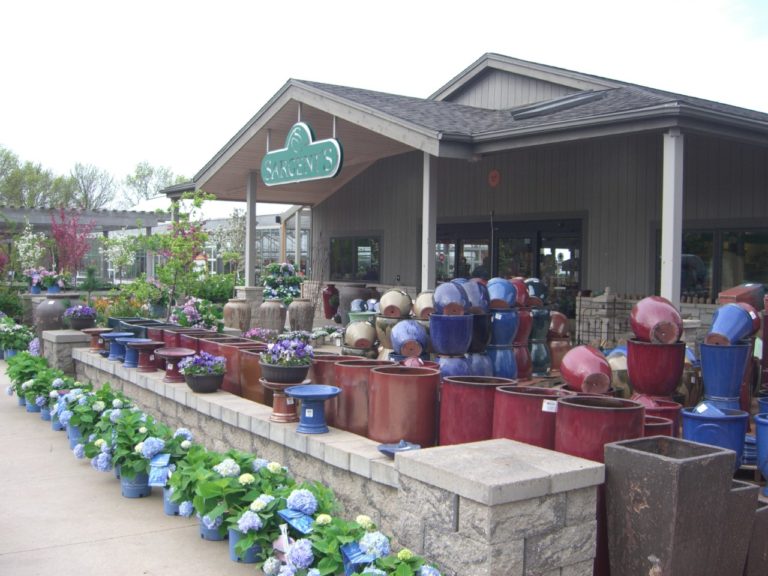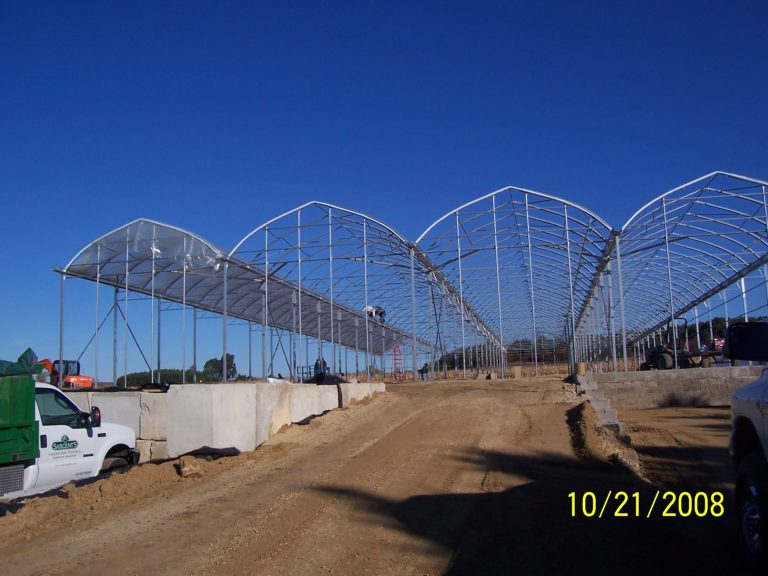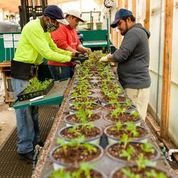Destination Sargent’s North!
In anticipation of vacating Sargent’s Garden Center at Miracle Mile, Forrest Sargent purchased forty acres of pastureland along Eighteenth Avenue Northwest in Rochester in the summer of 1974. The parcel was part of Louis and Emma Struck’s farm. In the spring of 1976, as Sargent’s moved the aluminum-framed greenhouse and two buildings from Miracle Mile to their new location, Mr. Struck was hired to plow up the west part of the pastureland on which Sargent’s planted their first crop of landscape plants. The plan was to run the landscape operation from Sargent’s North and grow a garden center retail department there from scratch. Minnesota Farm Builders out of Wanamingo, who had built the two structures that were moved, constructed a new 40-by-96–foot red pole barn that housed a small office and a dirt-floor warehouse.
Forrest recalls Sargent’s relocation: “My challenge was to take our Miracle Mile Shopping Center business, which was retail oriented and had much customer traffic, move it five miles out in the country on a secondary road, and have it become a destination location. We envisioned customers coming there knowing where they were going and why. We made the store’s atmosphere inviting—a park-like setting where customers could comfortably browse, shop, and see a multitude of plants and landscape designs. We did everything we could to create a fun, family atmosphere, including building a play structure and offering classes for kids.”
He adds, “We were ready and willing to give up the high traffic count at Miracle Mile. We thought that our landscape business was going well, and we would continue to do well no matter where it was located. So, instead of a retail dominant business like we were at Miracle Mile, we became a landscape dominant business with retail located at Sargent’s North.”
When Sargent’s North opened in 1976, Ted Bartel—a true plant nerd—was the field nursery foreman, and Mary Wallace and Lance Sorenson ran the front end of the business. Jeff Dirks and Paul Pike came soon after and were instrumental in the growth of the plant production department. Paul still works for Sargent’s and is their purchasing agent for woody plants and nursery stock. Paul played a key role in initiating and establishing their greenhouse production. Forrest calls him a “genius in many areas.”
Lance Sorenson had been working with Sargent’s in Red Wing in 1973. In the spring of 1974, he and his wife purchased a mobile home, moved it to the Sargent’s North site, and lived there the first two years he helped with business operations. Lance notes that he, Forrest, and the other employees had cordial and close working relationships. He contributes Forrest’s calm demeanor as contributing to this and shares the following story to illustrate it: “We hauled compost on an International two-ton truck with a cattle rack on it. One early spring Saturday, I was going to raise the box to dump a full load. The ground was uneven, so I mounded some soil and rock under one set of the rear dual wheels to level the load. As I pulled the lever to raise the box, I forgot to keep my foot on the brake. The International rolled forward with the full load raised, the load did not release, and as the truck rolled off the leveled area, it slowly tipped onto its side. I was unhurt, but the driver-side door, which was partially open, crumpled. Forrest came by shortly after I phoned for help. He calmly helped me clean up the mess and right the truck. We were able to find a door from a salvage yard to replace the wrecked door, but it was not the same color, and it was a constant reminder to me of my mishap.”
Sargent’s at Miracle Mile had built a loyal customer base, but Forrest knew it would be critical to retain the base and grow it by letting people know where they were and what they offered. He recalls, “When we opened in 1976, we advertised extensively. Our mantra was ‘buy from the grower,’ and we provided greenhouse and nursery crops. We held grand openings, gave away trees to our first one hundred customers at our spring open house, and, throughout the year, provided food and snacks (soda, popcorn, and more) to generate interest and attract customers.”
Mayo Clinic: A Key Client
Sargent’s North opened when the economy was healthy, and Rochester was thriving. About this time, Mayo Clinic became a key client. Mayo had been on a mission to green up their campus—starting with their parking lots—by installing plants, especially evergreens because they were green year around. Mayo CEO, Dr. Eugene Mayberry, was the visionary behind the movement. Working with the facilities engineering department, Sargent’s gradually made inroads into that business opportunity. Forrest’s father was the main landscape designer, and Forrest was the salesman. For many years, Sargent’s Landscape Nursery, Inc., was Mayo’s primary landscape contractor.
Forrest recalls, “We started with parking lots and then moved on to their Baldwin, Harwick, Hilton, St. Marys Peace Garden, and St. Marys Courtyards buildings. Snow removal for all the Mayo properties followed, and the winter work that contract provided gave year-round jobs to at least six of our regular landscape employees and others who had been working for us spring through fall. Our equipment and manpower were used effectively year around, which is significant and rather rare in our industry.”
Of Sargent’s many Mayo Clinic projects, their most challenging was the Baldwin Installation Project. Forrest reflects on its difficulty: “Nearly all of the work was done ‘up in the air’ and required the use of a towering crane. We trucked in hundreds of tons of specially prepared dirt that we put in the insulated planters, and then lifted hundreds of trees (about fifty of them were quite large) one by one up onto the building terraces. This was the biggest single installation project we taken on and completed at the time.”
Combining Family and Business
In 1983, Forrest and Faye decided to build a new home on five of Sargent’s North’s forty acres, and they moved there in December 1984. The proximity of their home to the business allowed them to combine work, family, and fun, and lasting impressions were made.
Forrest says, “Living on nursery property and growing up in a family business has its ups and downs. The upside of that environment was the boys (Dan and Nick, both in their teens) were able to work (willingly or perhaps less willingly at times) and make spending money at first and then real money as they became more productive. To begin, they mostly weeded, watered, dead-headed flowers, and did other rather boring tasks. As they grew older, their earning ability motivated them to work. They did sales work, helped customers with carryout, worked in the production greenhouses, and labored with the landscape crew. The downside is that they sometimes had to work when they may have wanted to do something more enjoyable. In addition, the tasks they were assigned may have been repetitious and not always fun, but they paid their dues without much complaint. An element of living in a family business environment is the inevitable talk around the dinner table regarding business activities. Both the risks and rewards of a small business and the entrepreneurial mindset were deeply embedded into their personalities and shaped their lives and careers. For our family, the positives far outweighed any negatives.”
From as early as age eleven, Nick worked in the store during the spring and tended to plants over the summer. He enjoyed the retail work, which consisted mostly of customer carry out assistance and watering or stocking plants, but he did not enjoy the summertime plant maintenance, and to some degree dreaded going in to work. Nick recalls his and his brother Dan’s first paying job at the nursery: “Dan and I divided ground cover Sedum plants and then repotted them into four-inch pots. Dad decided to pay us by the pot, not thinking too hard about the amount we would make. My brother, a scientist at heart, and I came up with an assembly line way to do this work, and the pay-per-pot motivated us to work quickly. We ended up getting a darned good hourly rate, and to this day I joke with Dad about that being the most money per hour I have ever made!”
Nick remembers that he and Dan, while working, always listened to their Walkman with earphones, which were quite novel at the time. Listening to music helped the work time go by more quickly for them. Nick says, “Somehow, Dan always ended up cutting the wire to his earphones while trimming plants, so he became an expert in fixing them himself. I must admit I did feel a bit superior to my older brother because I never cut my Walkman cord!”
When Nick reached the age of fifteen, he began going out on the trimming crew to pick up clippings. They did many apartment buildings and commercial buildings, as well as some homes. This was before leaf blowers became popular, so he had to rake and wheelbarrow, which was quite tedious. Initially, he did not like the trimming crew work (or later, landscape work), but over time he enjoyed it more and more, and his sense of accomplishment grew after each project. By the time Nick went off to the University of Minnesota, he was a summertime crew foreman and truly enjoyed what he did.
Forrest worked seven days a week during the busy spring and summer times of year. He says, “I was jack of all trades. I would wear my landscape hat during the week (selling and designing projects) and my retail hat weekends (working in the garden center).” After thirty years of seven day weeks he was able to cut back to not working weekends in the store. On top of his involvement in normal nursery and landscape activities, he would be heavily involved in the many building and remodeling projects that took place regularly over the years.
Business Success
Through hard work, foresight, exceptional employees, loyal customers, and good and poor economic times, since 1976 Sargent’s North has grown from a handful of buildings on forty acres to a 100-acre location that includes a garden center, multiple greenhouse complexes, a business office, an equipment maintenance shop, and a headquarters for landscape supply and operations.
Nick’s oldest child, Sophie, remembers how much she, her siblings (Maxwell and Jay), and cousins (Alec and Paige) loved visiting Forrest and Faye at their home and helping at Sargent’s North. She assisted Faye with office work, helped with the Sargent’s North monthly kids events (called Wee Wednesdays), and worked the popcorn stand to hand out free popcorn to customers every weekend in May. Sophie remembers Forrest reminding her to give popcorn to customers with a big smile and say “Thank you” for their shopping at the store. Of her grandfather she says, “Grandpa is a hardworking, people person. He listens to what people say and then gives them good advice, and he puts the highest priority on helping people in the community. From my perspective, those are the main reasons he has been so successful in his business.”

